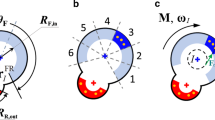Abstract
Recent studies have shown significant differences in migration mechanisms between two- and three-dimensional environments. While experiments have suggested a strong dependence of in vivo migration on both structure and proteolytic activity, the underlying biophysics of such dependence has not been studied adequately. In addition, the existing models of persistent random walk migration are primarily based on two-dimensional movement and do not account for the effect of proteolysis or matrix inhomogeneity. Using lattice Monte Carlo methods, we present a model to study the role of matrix metallo-proteases (MMPs) on directional persistence and speed. The simulations account for a given cell’s ability to deform as well as to digest the matrix as the cell moves in three dimensions. Our results show a bimodal dependence of speed and persistence on matrix pore size and suggest high sensitivity on MMP activity, which is in very good agreement with experimental studies carried out in 3D matrices.





Similar content being viewed by others
References
Burgess B. T., Myles J. L., Dickinson R. B. (2000) Quantitative analysis of adhesion-mediated cell migration in three-dimensional gels of RGD-grafted collagen. Ann. Biomed. Eng. 28(1): 110–118
Cukierman E., Pankov R., Stevens D. R., Yamada K. M. (2001) Taking cell-matrix adhesions to the third dimension. Science 294(5547): 1708–1712
Cukierman E., Pankov R., Yamada K. M. (2002) Cell interactions with three-dimensional matrices. Curr. Opin. Cell Biol. 14(5): 633–699
Dickinson R. B., Tranquillo R. T. (1993) Optimal Esitmation of Cell Movement Indices from the Statistical Analysis of Cell Tracking Data. AIChEJ. 39(12): 1995–2010
Discher D. E., Janmey P., Wang Y. L. (2005) Tissue cells feel and respond to the stiffness of their substrate. .Science 310(5751): 1139–1143
Dunn G. A. (1983) Characterising a kinesis response: time averaged measures of cell speed and directional persistence. Agents Actions Suppl. 12: 14–33
Friedl P., Brocker E. B. (2000) The biology of cell locomotion within three-dimensional extracellular matrix. Cell Mol. Life Sci. 57(1): 41–64
Friedl P., Wolf K. (2003) Tumour-cell invasion and migration: diversity and escape mechanisms .Nat. Rev. Cancer 3(5): 362–374
Giannone G., Dubin-Thaler B. J., Dobereiner H. G., Kieffer N., Bresnick A. R., Sheetz M. P. (2004) Periodic lamellipodial contractions correlate with rearward actin waves. Cell 116(3): 431–443
Harms B. D., Bassi G. M., Horwitz A. R., Lauffenburger D. A. (2005) Directional persistence of EGF-induced cell migration is associated with stabilization of lamellipodial protrusions. Biophys J. 88(2): 1479–1488
Kuntz R. M., Saltzman W. M. (1997) Neutrophil motility in extracellular matrix gels: mesh size and adhesion affect speed of migration. Biophys. J. 72(3): 1472–1480
Lauffenburger D. A., Horwitz A. F. (1996) Cell migration: a physically integrated molecular process. Cell 84(3): 359–369
Lutolf M. P., Lauer-Fields J. L., Schmoekel H. G., Metters A. T., Weber F. E., Fields G. B., Hubbell J. A. (2003) Synthetic matrix metalloproteinase-sensitive hydrogels for the conduction of tissue regeneration: engineering cell-invasion characteristics. Proc. Natl. Acad. Sci. U S A. 100(9): 5413–5418
O’Brien F. J., Harley B. A., Yannas I. V., Gibson L. (2004) Influence of freezing rate on pore structure in freeze-dried collagen-GAG scaffolds. Biomaterials 25(6): 1077–1086
Pek Y. S., Spector M., Yannas I. V., Gibson L. J. (2004) Degradation of a collagen-chondroitin-6-sulfate matrix by collagenase and by chondroitinase. Biomaterials 25(3): 473–482
Raeber G. P., Lutolf M. P., Hubbell J. A. (2005) Molecularly engineered PEG hydrogels: a novel model system for proteolytically mediated cell migration. Biophys. J. 89(2): 1374–1388
Ridley A. J., Schwartz M. A., Burridge K., Firtel R. A., Ginsberg M. H., Borisy G., Parsons J. T., Horwitz A. R. (2003) Cell migration: integrating signals from front to back. Science 302(5651): 1704–1709
Shreiber D. I., Barocas V. H., Tranquillo R. T. (2003) Temporal variations in cell migration and traction during fibroblast-mediated gel compaction. Biophys. J. 84(6): 4102–4114
Wolf K., Mazo I., Leung H., Engelke K., von Andrian U. H., Deryugina E. I., Strongin A. Y., Brocker E. B., Friedl P. (2003) Compensation mechanism in tumor cell migration: mesenchymal-amoeboid transition after blocking of pericellular proteolysis. J. Cell Biol. 160(2): 267–277
Zaman M. H., Kamm R. D., Matsudaira P., Lauffenburger D. A. (2005) Computational model for cell migration in three-dimensional matrices. Biophys. J. 89(2): 1389–1397
Zaman M. H., Trapani L. M., Siemeski A., Mackellar D., Gong H., Kamm R. D., Wells A., Lauffenburger D. A., Matsudaira P. (2006) Migration of tumor cells in 3D matrices is governed by matrix stiffness along with cell-matrix adhesion and proteolysis. Proc. Natl. Acad. Sci. U S A 103(29): 10889–10894
Acknowledgements
The authors would like to thank Professors R. Dickinson, A. Mogilner for their insightful comments on our simulation methods and analysis. This work was supported by NIH grant R01-GM 57418 (PM), NSF grant NIRT 0304128 (PM), the NIGMS Cell Migration Consortium (DAL), the NCI Integrative Cancer Biology Program (DAL).
Author information
Authors and Affiliations
Corresponding author
Rights and permissions
About this article
Cite this article
Zaman, M.H., Matsudaira, P. & Lauffenburger, D.A. Understanding Effects of Matrix Protease and Matrix Organization on Directional Persistence and Translational Speed in Three-Dimensional Cell Migration. Ann Biomed Eng 35, 91–100 (2007). https://doi.org/10.1007/s10439-006-9205-6
Received:
Accepted:
Published:
Issue Date:
DOI: https://doi.org/10.1007/s10439-006-9205-6




